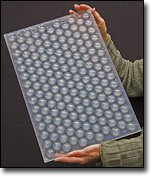Pioneering Technology Lab Now Puts Energy Into Solar
Promising approach may make sun-fed power competitive with fossil fuels for the first time, experts say
Over the years, the Palo Alto Research Center has developed numerous electricity-gobbling innovations.
Now, the storied lab that gave the world laser printing and graphical user interfaces is trying to harness the sun to power its inventions.
The Xerox Corp. subsidiary known as PARC has produced superefficient solar systems that experts say could make photovoltaic power -- sunlight converted directly into electricity -- available on a large scale at prices competitive with fossil fuels for the first time. PARC's technology is one of several promising approaches in the field.
"Solar is growing at 30 percent annually," said analyst Ron Pernick of Clean Edge Inc., a research organization that specializes in alternative energy technology.
Comparing the expansion to the best years of the personal-computer industry, Pernick forecasts that solar power will be a $51 billion global business in 2015, up from $11.2 billion last year.
The research at PARC is part of an eco-friendly technology trend that draws on the materials and know-how that built computer microprocessors and other high-tech staples.
In an era of stratospheric oil prices, investors are beginning to see solar as the next big thing, despite its embryonic state. Many industry watchers expect to see large rooftop collectors for powering businesses, and solar farms that will approach the size of major power plants.
"The electricity market is as big as the sky," said Erik Straser of Mohr Davidow Ventures in Menlo Park, who has invested in emerging solar companies.
That hopefulness stems from dramatic technology changes. For decades, solar power was dominated by thermal systems that heat water for bathing or power small turbines to create electricity. Photovoltaic technology -- the combination of light and electricity -- gradually is replacing thermal.
At the core of photovoltaic cells are semiconductor materials such as silicon. Solar rays knock electrons loose from silicon atoms; those electrons are drawn off to create a current. Solar arrays combine many cells.
 The first generation of photovoltaic technology was based on large, heavy collectors -- costly, inefficient systems that converted only 10 percent to 15 percent of solar rays to power. The rest reflected away or diffused as waste heat.
The first generation of photovoltaic technology was based on large, heavy collectors -- costly, inefficient systems that converted only 10 percent to 15 percent of solar rays to power. The rest reflected away or diffused as waste heat.Recently, a handful of companies have developed systems that use mirrors or lenses to concentrate the sun's rays as much as 500 times and increase efficiency to as much as 26 percent, with projections up to 50 percent. Higher efficiency means cheaper power.
Several such "concentrating photovoltaic" schemes have been devised.
PARC's concentrating technology was developed with SolFocus, a start-up being incubated inside PARC. The first-generation system comprises grids of solar collectors about 8 inches thick. Metal cones and optical systems concentrate sunlight on a 1-square-centimeter solar chip.
The second-generation system shrinks the collectors 90 percent and makes them about half an inch thick, creating a honeycomb of precision-molded glass coated with mirrors. The newer technology uses chips just 1 millimeter square made from layers of germanium and silicon. The layers absorb different parts of the solar spectrum to increase efficiency.
Their small size would make the collectors more economical and easier to mount on the rooftops of commercial buildings, such as big-box retailers in sunny climates. Last year, SolFocus' entry beat more than 100 competing designs to win the National Renewable Energy Laboratory Growth Forum award.
PARC estimates that the new system will easily compete with fossil fuels at today's prices, although it won't be ready for commercial use for a few years.
By Charles Piller LOS ANGELES TIMES
• Read more about PARC's Clean Tech research
• Read more about Concentrator PV (CPV)







0 Comments:
Post a Comment
<< Home